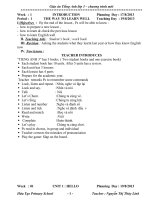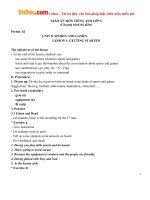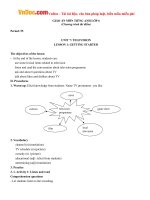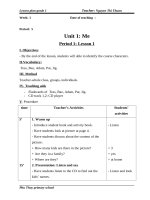giáo án tiếng anh lớp 1 giáo trình ilearn smart start
Bạn đang xem bản rút gọn của tài liệu. Xem và tải ngay bản đầy đủ của tài liệu tại đây (87.83 KB, 6 trang )
<span class='text_page_counter'>(1)</span><div class='page_container' data-page=1>
<b>i-Learn Smart Start 1</b>
<b>Week: 16th</b><sub> Date of teaching: December 21</sub>st<sub>, 2020</sub>
<b>Period: 31st<sub> </sub></b>
<b>UNIT 5: ANIMALS</b>
<b>Lesson 3</b>
<b>I. Objectives:</b>
By the end of this lesson, students will be able to say the names of some animals using “This is a …”
<b>II. Teaching aids:</b>
<b>Teacher’s aids: student’s and teacher’s book, class CDs, flashcards, IWB software, </b>
projector/interactive whiteboard/TV.
<b>Students’ aids: books, notebooks, workbooks.</b>
<b>III. Languages focus:</b>
<b>Vocabulary: monkey, snake, bear</b>
<b>Structure: </b>
This is a (monkey).
<b>IV. Procedures:</b>
<b>Time</b> <b>Steps/Activities</b> <b>Organization</b>
5’
<b>Warm-up</b>
- Option 4: Review. Listen and jump or clap.
Play audio CD-73. Have students jump when they hear “g”
sound and clap when they hear the “h” sound.
- Option 2: Review. Look and say.
Teacher holds the flashcards “girl” and “hop”.
Teacher says “g…g..” then have students say the word “girl”.
Teacher says “h…h..” then have students say the word “hop”.
Teacher points to the “girl” flashcard and says “This is a…”
then have students say the word “girl”.
Teacher points to the “hop” flashcard and says “I can…” then
have students say the word “hop”.
Teacher can say or point faster to challenge the students.
Invite some students to hold the flashcards to do the same.
- Option 3: Review. Look and say.
Teacher holds the flashcards “cat”, “dog” and “bird”.
Use a paper to cover the flashcards and reveal each one slowly.
Students say the name of the animal in the flashcard.
Teacher can says “I like…” when revealing the flashcard.
Have students to say “ I like …”.
- Option 4: Review. Use games on i-ebook to review.
Teacher –
whole class
Individuals
Teacher –
</div>
<span class='text_page_counter'>(2)</span><div class='page_container' data-page=2>
25’ <b>New lesson</b>
<b>New words- Listen and point. Say (10’)</b>
1. Arrange the flashcards on the board, play audio CD-74, and have
students listen and repeat. Point to the flashcards along with the
audio. Repeat several times.
2. Play audio again and have students listen, repeat, and point to the
pictures in their books.
3. Change the order of the flashcards, point to them individually and
have students say the words, correct pronunciation when needed.
<b>Activities:</b>
Option 1: Play "Guess."
Arrange the flashcards on the board and write a number under
each card.
Have students look at the flashcards and remember its position
for 5 seconds.
Ask students to head down/ close their eyes.
Turn the flashcards over to face the board.
Call out a number and have students take turns to guess the
face-down card. Turn the card over after each guess.
Option 2: TPR practice
Say the word and all together make the gestures/ sound
according to the word (Ex: monkey- kec kec, use hands to do
actions like a monkey).
Teacher can make the gestures and have students guess what
animal is.
Or Teacher can say an animal and have students make the
gestures.
<b> Option 3: Game on i-ebook</b>
<b>Listening- 1. Listen and point. (5’)</b>
1. Have students call out the things they can see in this part.
2. Have students listen and follow.
3. Play audio CD- 75 and demonstrate pointing to the animals.
4. Play audio again. Have students listen and point to the animals.
<b>Listening- 2. Listen and repeat. (5’)</b>
1. Have students look at the useful language box.
2. Play audio CD-76. Have students listen to the useful language.
3. Have students practice the useful language when pointing to the
picture of the animals.
<b>Activities: (</b><i><b>optional</b></i><b>)</b>
Option 1: Look, listen and say “Yes” or “No”.
Teacher holds a flashcard and says a sentence “ This is a …”.
The animal in the flashcard and the animal in the sentence the
teacher said maybe the same or different.
Students say “Yes” if the animal in the flashcard and the animal
in the sentence the teacher said are the same.
Students say “No” if the animal in the flashcard and the animal
Teacher –
whole class
Individuals
Students in
groups/
individuals
Teacher –
whole class
Teacher –
whole class
Teacher –
whole class
Teacher –
</div>
<span class='text_page_counter'>(3)</span><div class='page_container' data-page=3>
in the sentence the teacher said are different.
Invite some students to hold the flashcards and say.
Option 2: Look and say.
Teacher holds a flashcard (the pictures face to the teacher) and
quickly reveal each one.
Students say “This is a…” according to the animal they saw in
the flashcard.
Option 3: Game on i-ebook
<b>Speaking- Play “Stepping stones”. (5’)</b>
1. Divide the class into pairs.
2. Have Student A start at A and say the first sentence, using “This is
a…”.
3. Have Student B start at B and say the first sentence.
4. Have students take turns saying the sentences and go all the way
round.
<b>Activities: (</b><i><b>optional</b></i><b>)</b>
Option 1: Listen and stand up.
Give 6 flashcard (cat, dog, bird, snake, bear, monkey) to 6
students in the class.
Invite 1 student to stand up and hold the flashcard up high and
say a sentence, using “I like… or This is a …” with name of an
animal in the flashcard of the other friends.
The boy/girl with the flashcard of the animal called will stand
up and hold the flashcard up high and say a sentence, using “I
like… or This is a …” with name of an animal in the flashcard
of the other friends.
Teacher can give the flashcard from 1 student to another student
during the activity.
Option 2: Game on i-ebook
Teacher –
whole class
Students in
pairs
Individuals
5’
<b>Wrap-up</b>
- Option 1: Review. Listen and point.
Arrange all the flashcards of Unit 5 in different area on the
board.
Teacher says a name of a flashcard.
Students use their fingers to point to the flashcard and say it
loudly.
- Option 2: Review. Look and say.
Arrange all the flashcards of Unit 5 in different area on the
board.
Teacher points to a flashcard.
Students say a sentence related to the flashcard, e.g. “I like…,
This is a …, I can hop”.
Teacher –
</div>
<span class='text_page_counter'>(4)</span><div class='page_container' data-page=4>
<b>Week: 16th</b><sub> Date of teaching: December 23</sub>rd<sub>, 2020</sub>
<b>Period: 32nd<sub> </sub></b>
<b>UNIT 5: ANIMALS</b>
<b>Lesson 3</b>
<b>I. Objectives:</b>
By the end of this lesson, students will be able to apologize using “I’m sorry.” and forgive using
“That’s OK.”
<b>II. Teaching aids:</b>
<b>Teacher’s aids: student’s and teacher’s book, class CDs, flashcards, IWB software, </b>
projector/interactive whiteboard/TV.
<b>Students’ aids: books, notebooks, workbooks.</b>
<b>III. Languages focus:</b>
<b>Vocabulary: sorry, OK</b>
<b>Structures: </b>
I’m sorry.
That’s OK.
<b>IV. Procedures:</b>
<b>Time</b> <b>Steps/Activities</b> <b>Organization</b>
5’
<b>Warm-up</b>
- Option 1: Review. Play "Heads up. What's Missing?"
Divide the class into teams.
Arrange the flashcards on the board and remove one card when
students are not looking.
One student from each team calls out the missing flashcard.
- Option 2: Review. Play the game “Lips read”.
Teacher says a word or a sentence silently.
Students say that word or that sentence loudly.
- Option 3: Review. Play the game “Flash look and say”.
Teacher shows a flashcard quickly.
Students say that word or a sentence, using “I like…, This is a
…” .
- Option 4: Game on i-ebook
Students in
groups
Teacher –
whole class/
groups/
individuals
20’ <b>New lesson</b>
<b>Story- 1. Listen to the story. (5’)</b>
1. Introduce the situation. Ask students some questions about the
pictures, e.g. “What can you see in the picture? What is this? Where
are the boys?...
2. Have students call out the people or things they can see.
3. Play audio CD-77 and have students listen and follow the story.
4. Play the audio again and have student listen and read.
Teacher –
</div>
<span class='text_page_counter'>(5)</span><div class='page_container' data-page=5>
<b>Story- 2. Listen and repeat. (5’)</b>
1. Have students look at the useful language box.
2. Play audio CD-78. Have students listen to the useful language.
3. Have students practice the useful language.
<b>Activities: (</b><i><b>optional</b></i><b>)</b>
Game on i-ebook
<b>Play and Say- Role play. (10’)</b>
1. Divide the class into pairs.
2. Have students practice the dialogue.
3. Swap roles and repeat.
4. Afterwards, have some pairs demonstrate the activity in front of the
class
<b>Activities: (</b><i><b>optional</b></i><b>)</b>
Option 1: Role play a situation
Number the situation in the role play 1-3
Have students work in pairs. Choose a situation to practice,
copy the actions in the situation.
Have some pairs come to the board and role play the situation
they chose.
Option 2: Game on i-ebook
Students in
pairs
Students in
pairs
Students in
pairs
10’
<b>Workbook</b>
<b>A- Trace the correct words. (4’)</b>
Have students use their pencil to trace the correct words.
Teacher go around to support, point to a picture and ask
students to read out the correct words.
<b>B- Circle the correct words. (2’)</b>
Have students use their pencil to circle the correct words.
Teacher go around to support and ask students to read out the
words or the sentences.
<b>C- Trace the words. (4’)</b>
Have students use their pencil to trace the words.
Teacher go around to support and ask students to read out the
sentences.
<b>Activities: (</b><i><b>optional</b></i><b>)</b>
Option 1: Role play a situation
Have students work in pairs and think of a new situation that
they can use the structures “I’m sorry. – That’s OK”.
Teacher can provide some common situations at school, in the
classroom or at home.
Have students role play their situation.
Have some pairs come to the board and role play the situation
they found.
Option 2: Game on i-ebook
Teacher –
whole class
Students in
</div>
<span class='text_page_counter'>(6)</span><div class='page_container' data-page=6></div>
<!--links-->









